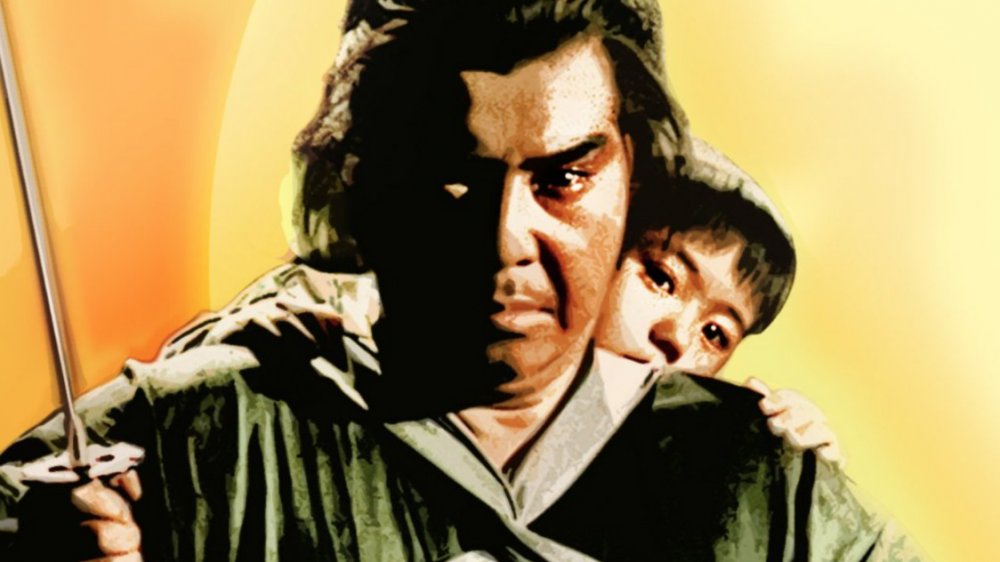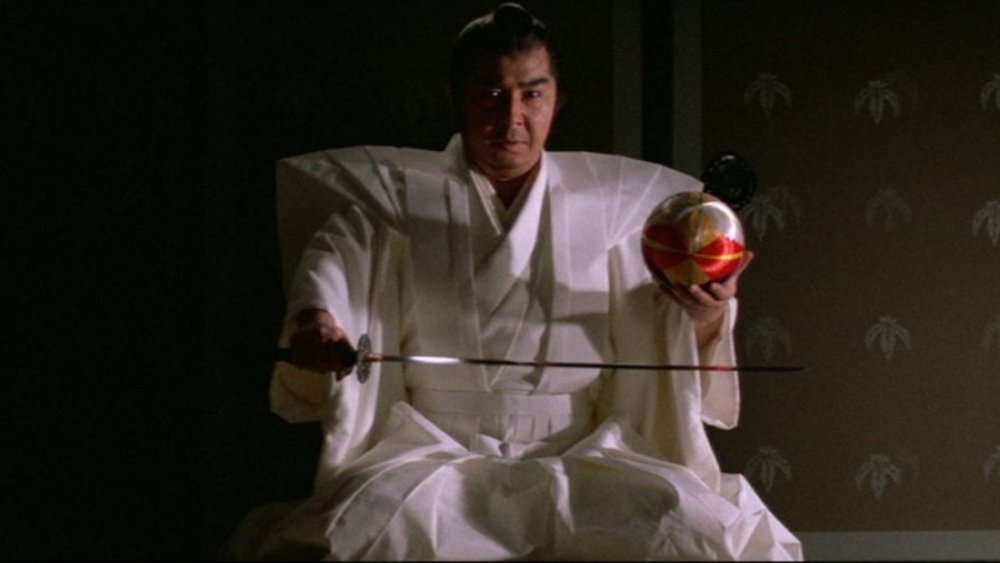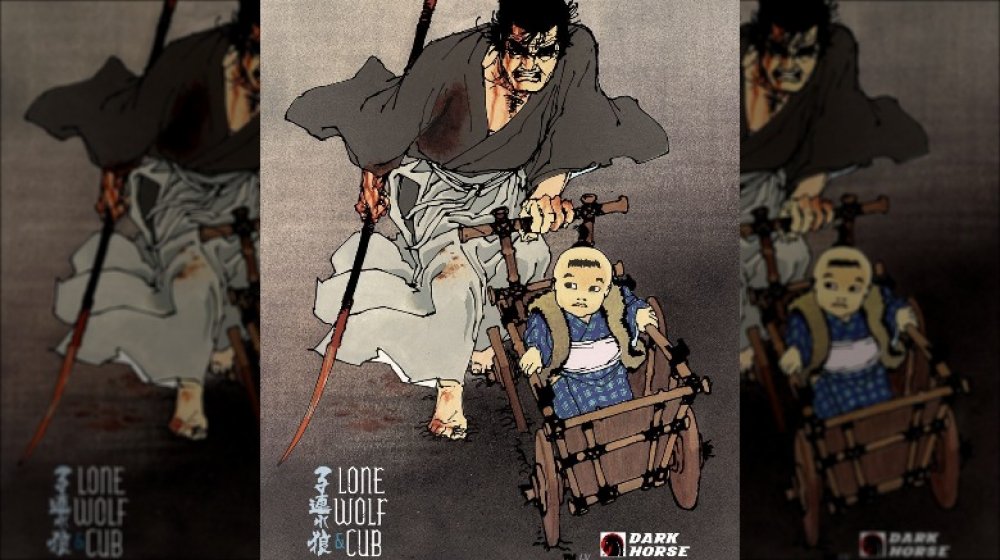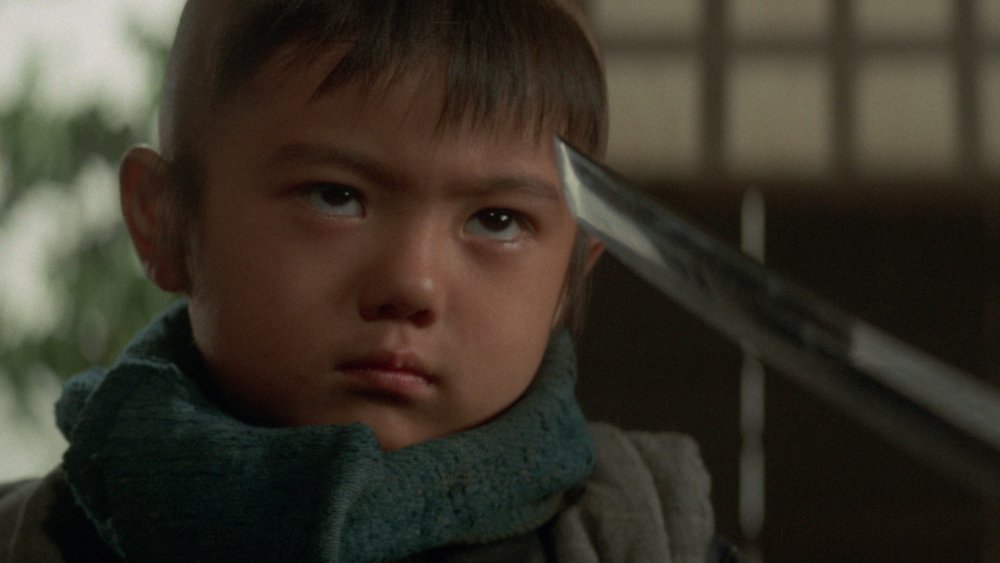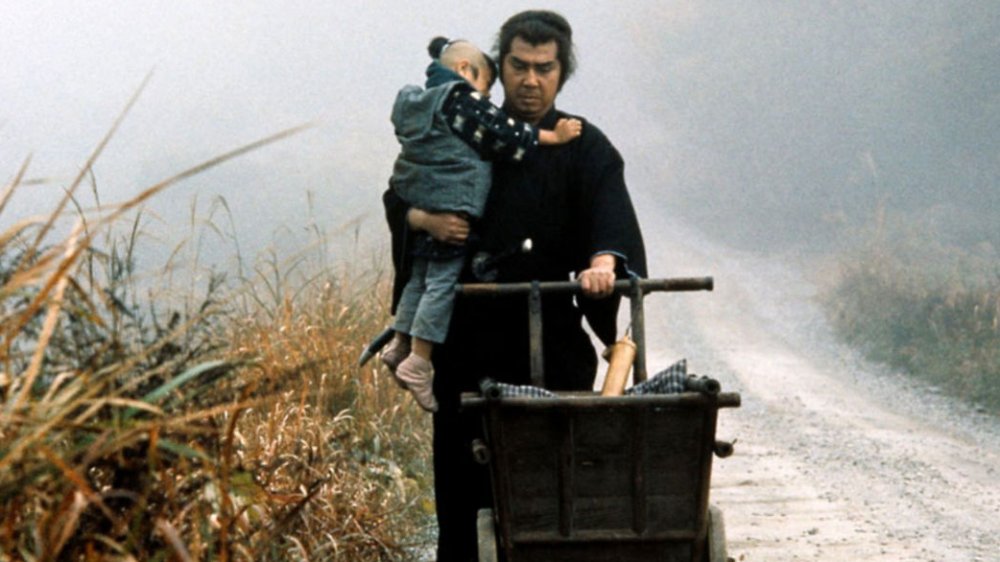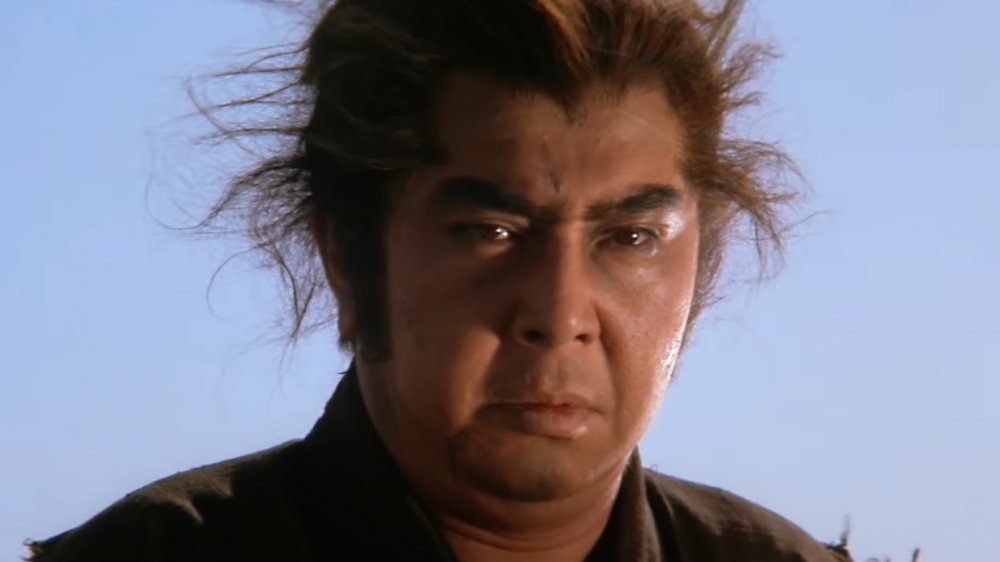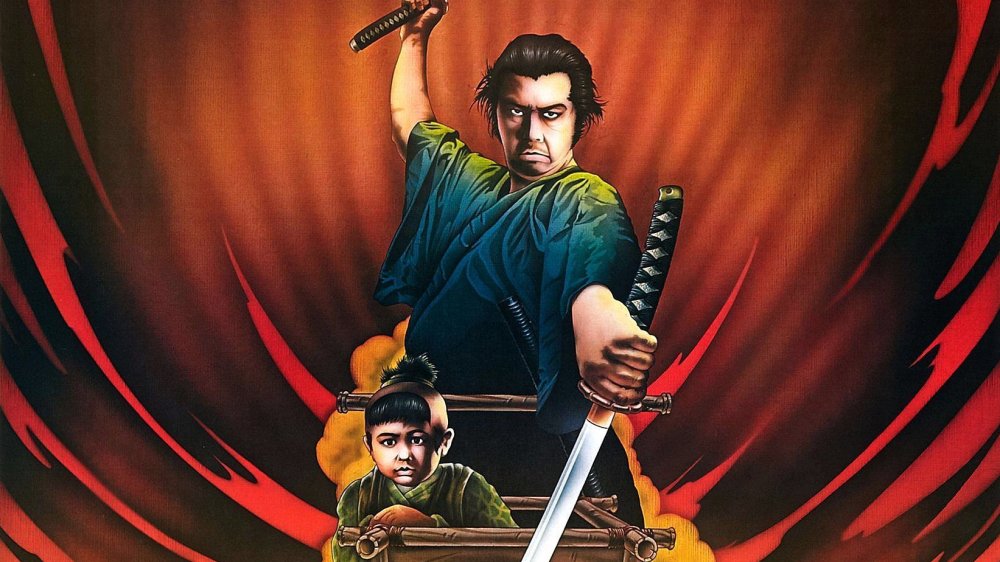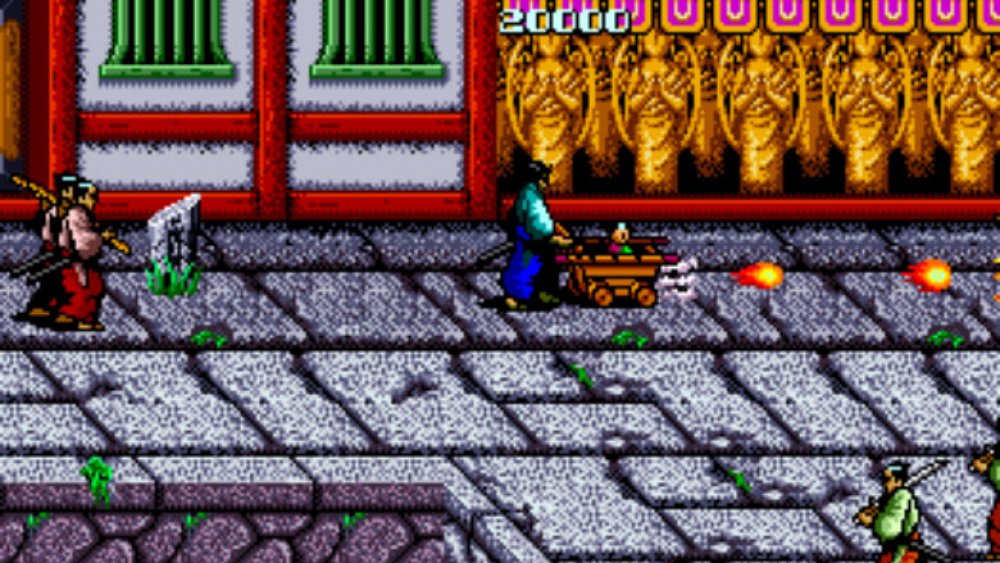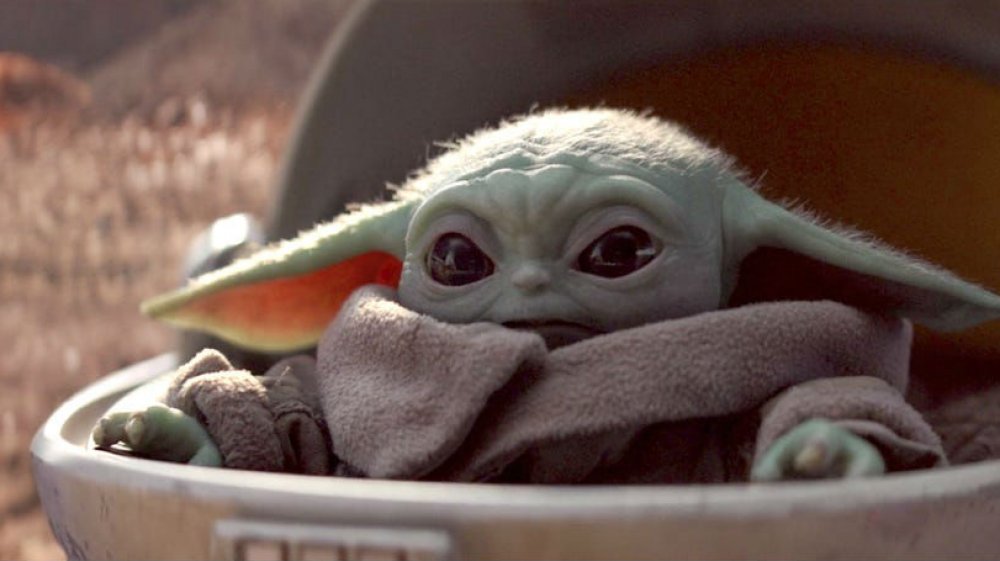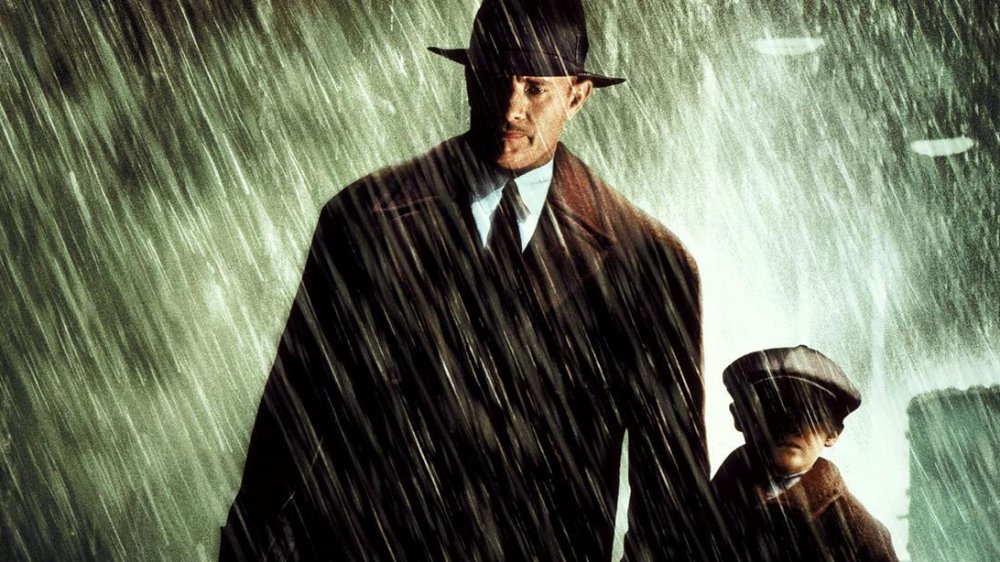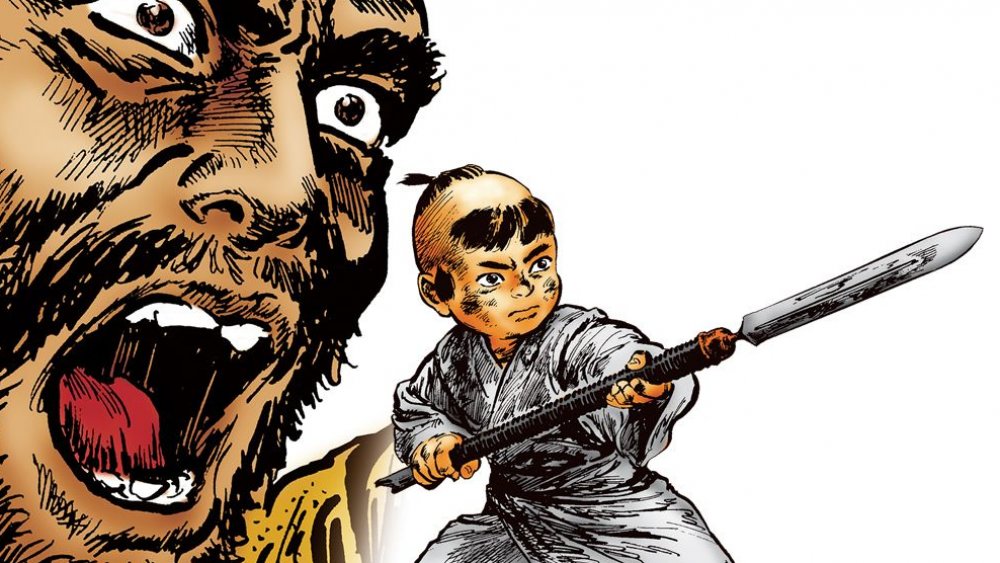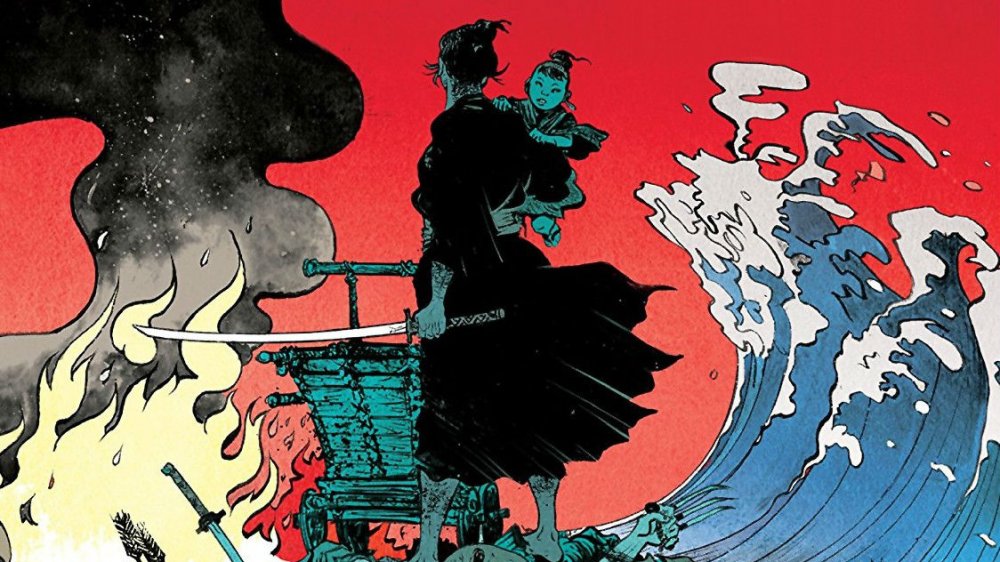The Untold Truth Of Lone Wolf And Cub
As early as almost a full year before the first episode of The Mandalorian was streaming on Disney+, rumors persisted that the Star Wars series would be partly inspired by the '70s manga Lone Wolf and Cub and the live-action films that adapted the bloody tale. Once the series premiered in 2019 and the first episode ended with the now famous Baby Yoda reveal, the comparisons to Lone Wolf and Cub flowed freely.
The Mandalorian has proven to be the most recent example in a long list of TV shows, movies, comic books, and more influenced by Lone Wolf and Cub. Iconic pop culture artists like Quentin Tarantino and Frank Miller have never been shy about the inspiration they've culled from the tale. But as powerful an influence as Kazuo Koike and Goseki Kojima's epic tale of samurai revenge has proven to be, most fans aren't as familiar with Lone Wolf and Cub as they are with the works it helped inspire.
If you're one of those fans and you're curious about the origins of these groundbreaking comics and the films adapted from their panels, keep reading for the untold truth of Lone Wolf and Cub.
The story of Lone Wolf and Cub begins with a choice
Lone Wolf and Cub first appeared as a manga in a 1970 issue of Japan's Manga Action. Its main character, Ogami Itto, is a disgraced samurai on a journey of revenge against Yagyu Retsudo, the powerful samurai who conspired to plunge Itto's clan into disgrace. Having resolved himself to his course, Itto isn't sure what to do about his newborn son, Daigoro, so he offers the boy a choice between a ball and a sword. If Daigoro chooses the ball, it means he wants to remain a child, and Itto will kill him in order to return him to his dead mother's arms. If Daigoro chooses the sword, it means he wants to walk what Itto calls the "Assassin's Road." Daigoro seems briefly attracted to the ball, though he ultimately reaches for the sword.
The conception of Lone Wolf and Cub was partly inspired by what its author, Kazuo Koike, saw as deteriorating family values in Japan. He wanted his story to serve as an example of an invincible bond between father and son, and the narrative reflects this almost supernatural connection between Itto and Daigoro. Multiple times, Itto comes across men and women who attempt to shame him for bringing Daigoro along on his quest. But these accusations don't put a dent in Itto's resolve. The assassin tells his accusers, "A father knows his child's heart, as only a child can know his father's."
It's a samurai epic set in Japan's Edo period
Itto travels across Japan on foot, with his son accompanying him in a bamboo baby cart. To passersby, he seems like little more than an unemployed ronin, but soon, he gains a reputation as the deadliest assassin in all of Japan. Sometimes, Itto actually uses Daigoro to help in his work. For example, Daigoro pretends to be drowning in a pond. When a ronin who Itto has been hired to kill passes by, he's forced to unstrap his signature pair of flintlock pistols before diving in to the water to save Daigoro, rendering him vulnerable to the waiting Itto.
For much of Lone Wolf and Cub, we don't know exactly how Itto's assassinations contribute to his revenge against the Yagyu clan. While occasionally the Yagyu clash with Itto and his son, most of Itto's jobs have nothing directly to do with the messed up samurai. Towards the end of the series, however, we learn Itto is saving money to amass an arsenal of explosives for his son to use in their final battle against the Yagyu.
On their path of revenge, Itto and Daigoro touch just about every corner of Edo-period Japanese society, from rogue daimyo to the impoverished farmers and abused sex workers of the era. In the meantime, readers are treated to the cinematic art of Goseki Kojima, whose stunning visuals bring the mountains, streams, and dangerous roads of Edo period Japan to life.
Daigoro is the vulnerable heart of Lone Wolf and Cub
Most Lone Wolf and Cub stories revolve around Itto, but occasionally, the focus switches to the young Daigoro. For example, there's "Tragic O-Sue," when Daigoro is imprisoned for fighting back against a bully while his father endures a deadly fever. The boy's resolve in the face of hunger and beatings stuns his captors, convincing them he's more than he appears. In a later story, "Parting Frost," a samurai is so impressed by what he calls Daigoro's "swordsman eyes" that he's convinced Daigoro is as much a warrior as himself.
More heartbreaking are stories that show us how much Daigoro yearns to have a normal life. There's "Black Wind," when Itto and Daigoro spend a relatively peaceful interlude planting rice in a farming community. Ultimately, we learn Itto is doing this as part of a quest, but regardless, Daigoro hopes his father has decided to finally set aside their bloody journey.
But more than any other chapter of the series, "Hunger Town" is sure to make you angry cry. Itto is hired to murder a despotic lord who's known to hunt dogs for sport. In order to lure him into the killing zone, Itto trains a puppy that Daigoro quickly falls in love with. Itto's target kills the puppy when it's inches away from Daigoro's arms, and when Itto murders the lord, it's the first time in the series we see Daigoro joyful at one of his father's kills.
It was adapted into six hit movies
It didn't take very long for Japanese movie studios to see the potential of Lone Wolf and Cub. In 1972 — two years after the story premiered in Manga Action — not one or two but four adaptations of the manga showed up in Japanese theaters. The first was Lone Wolf and Cub: Sword of Vengeance, followed by Baby Cart at the River Styx, Baby Cart to Hades, and Baby Cart in Peril. The fifth film, Lone Wolf and Cub: Baby Cart in the Land of Demons, hit theaters in 1973, with the sixth and final installment, Lone Wolf and Cub: White Heaven in Hell, premiering in 1974.
The films star Tomisaburo Wakayama as the disgraced samurai Ogami Itto and the young Akihiro Tomikawa as his son Daigoro. While the films don't (and couldn't possibly) adapt every chapter of its source material, they're known for their faithfulness to the manga, due in no small part to the fact that Kazuo Koike was a scriptwriter on all but the sixth and final film.
The star of the Lone Wolf and Cub films got the role with a unique audition
One of the in-jokes among Lone Wolf and Cub fans is the surprising physicality of the films' lead, Tomisaburo Wakayama. When he starred in the samurai films, Wakayama appeared to be carrying some extra weight. He never looks to be morbidly obese by any stretch, but he seems far from the samurai who performs so many impossible physical feats in the source material.
Wakayama was not ignorant that this would seem like a contradiction, and he took an unorthodox approach to securing the role of the vengeful samurai. The actor appeared unannounced at Lone Wolf and Cub author Kazuo Koike's home with a wooden practice samurai sword. Wakayama, having appeared in many action movies and kabuki stage productions, was no stranger to swords. Sensing Koike was concerned about his weight, the actor said, "If you're hesitant to let me play this part because I'm too fat ... look at this!" According to Patrick Macias' essay for the Criterion Collection, Wakayama then impressed the author with a series of "swordplay and somersaults." The actor succeeded and won the author's blessing.
Lone Wolf and Cub came to America on the page and the screen
American audiences were introduced to the epic of Lone Wolf and Cub in 1980. Compiled mostly from the second Japanese film with some footage from the original Sword of Vengeance, 1980's Shogun Assassin became a grindhouse classic. And you may have unknowingly at least heard some of the film. Toward the end of Kill Bill Vol. 2, Quentin Tarantino delivers an awesome Easter egg. In the scene where the Bride's newfound daughter asks to watch a movie before bedtime, she winds up viewing some of Shogun Assassin, and we actually hear Daigoro's narration before the Bride leaves her daughter's side to confront Bill.
However, it would take longer for the source material to be translated for American comics readers. In 1986, the now defunct First Comics brought the Lone Wolf and Cub manga to American shores. While the original Japanese series was printed in the anthology publication Manga Action, First Comics published Lone Wolf and Cub as single issue comics with most issues reprinting and translating one or two of the epic's chapters. Already a comic book star because of his work on Daredevil, Ronin, and The Dark Knight Returns, Frank Miller wrote introductions for the first 12 issues of the series. Unfortunately, First Comics closed its doors in 1992 and didn't get the chance to give American readers a complete story.
Finally between 2000 and 2002, Dark Horse Comics reprinted the entire series in 28 trade paperbacks, each around 300 pages in length.
It inspired a hard to find video game
If you're a fan of video games, particularly open-world sandbox fare, reading Lone Wolf and Cub may make you wonder why there isn't a hit video game series ready for you to grind. After all, it has some of the elements of a game like Red Dead Redemption built in, such as a morally ambiguous hero traveling where he will in an expansive, gorgeous landscape and a larger quest punctuated with smaller countless "side quests" (i.e., all the assassination jobs Itto takes on his journey).
Yet somehow, the only Lone Wolf and Cub game known to exist was released only in Japan. In 1987 Nichibutsu released Kodure Ookmai, a beat-em-up featuring a samurai pushing a baby cart through endless crowds of Yagyu ninja and rival samurai. The game was never released in the US, and it's infamously difficult to get ahold of.
The Mandalorian is inspired by Lone Wolf and Cub
If you know of Lone Wolf and Cub, it's impossible to not see the similarities with Jon Favreau's The Mandalorian. Both Itto and Mando are mercenaries of legendary repute, both are accompanied by a toddler on their adventures, and both toddlers end up sometimes helping in the work. Add to that the Western and samurai inspirations obvious not only in The Mandalorian, but in the Star Wars movies as a whole, and it's clear Itto and Daigoro have left an mark on the sci-fi franchise that can't be ignored.
Perhaps more than any other episode, Chapter 4 of The Mandalorian will remind Lone Wolf and Cub fans of some of the more heartbreaking moments of the manga. Mando is hired by a village of farmers to protect them from nearby raiders. While Mando prepares for his work, the Child becomes the most popular addition in the village, regularly playing with the other kids. Mando plans to leave the Child there, but by the end of the episode it becomes clear the many assassins tracking the boy will keep after him no matter where he is.
As the village children are forced to say goodbye to Baby Yoda, it's impossible for Lone Wolf and Cub fans to not remember stories like "Black Wind" and "Hunger Town," which dangle the promise a more normal life in front of Daigoro, only to set him back on the bloody assassin's road by the end.
It's influenced pop culture more than you know
It's likely you've watched or read media inspired by Lone Wolf and Cub even if you don't know it. For example, while you probably wouldn't expect Tom Hanks to be within 100 miles of a Lone Wolf and Cub-inspired project, Road to Perdition — one of the greatest revenge movies ever — owes a large thanks to the manga. Following a hitman on the run from his former crime boss, with his son in tow, Road to Perdition is based on a 1998 graphic novel of the same name by Max Allan Collins. The writer/artist has been clear about his debt to the earlier manga.
The series' influence can also be massively felt on the work of comic book legend Frank Miller. It's not only evident in his own samurai story, Ronin, but also in the Sin City comics and the films inspired by them. And, of course, Quentin Tarantino is blatant about the influence of Lone Wolf and Cub in his Kill Bill films. Along with the callbacks to '70s samurai movies, it's the Lone Wolf and Cub adaptation Shogun Assassin that Beatrice's daughter watches before bedtime. And at the end of the film when Beatrice has taken her daughter back from Bill, we're told the lioness has been reunited with her "cub."
In the 21st century, Lone Wolf and Cub made its return
If you haven't read the Lone Wolf and Cub manga, beware big SPOILERS follow.
In the beginning of the new century, Kazuo Koike decided it was time to expand on the story of Daigoro with New Lone Wolf and Cub.
Lone Wolf and Cub ends with its 142nd chapter, "Arms." After a long duel between Itto and Retsudo — a fight that spans three chapters all on its own — Itto sadly succumbs to his wounds and dies. With tears streaming down his cheeks, Daigoro finds the broken end of a spear and charges Retsudo, who inexplicably embraces the boy as he rushes him. Retsudo is impaled by the spear and, dying, cradles the sobbing boy in his arms. In his final breaths, he calls Daigoro "grandson ... of my heart."
In an epilogue at the end of New Lone Wolf and Cub Vol. 1, Koike explains that in 2002 — around the same time he was wondering what exactly happened to Daigoro at the end of his story — he was approached by the magazine Shukan Post to write a sequel to his samurai epic. New Lone Wolf and Cub opens exactly where Lone Wolf and Cub ends, with Daigoro on the beach and the corpses of his father and Retsudo nearby. After Daigoro collapses from fatigue and despair, the samurai Togo Shigetada finds him and takes him under his wing.
An updated Lone Wolf and Cub could be on the horizon
For a couple of decades there have been rumors and rumblings about a Lone Wolf and Cub remake, though — perhaps fittingly, considering the story's heroes see themselves traversing a road to hell — nothing has yet managed to fully emerge from that hated Hollywood development hell.
Darren Aronofsky, perhaps best known for 1998's Pi and 2000's Requiem for a Dream, was reportedly pursuing a new adaptation of the samurai epic as early as early as 2003, according to Entertainment Weekly. It was one of a number comic book movies Aronofsky wanted to adapt, including scrapped plans for Batman: Year One and Ronin, the latter of which was strongly influenced by Lone Wolf and Cub. By 2009, Aronofsky was saying that the project had gone belly-up, mainly because of rights issues.
In more recent years, it looks like whatever rights complications held up Aronofsky were cleared for a new creative team. In October 2017, The Hollywood Reporter said that Paramount would be producing the newest adaptation of Lone Wolf and Cub. Justin Lin of the Fast and Furious films was identified as a possible director, with Andrew Kevin Walker — a scriptwriter on Seven, Sleepy Hollow, and 8MM among others — attached to write. We haven't heard much since that announcement, so only time will tell if we'll see a new movie take on this bloody epic.
